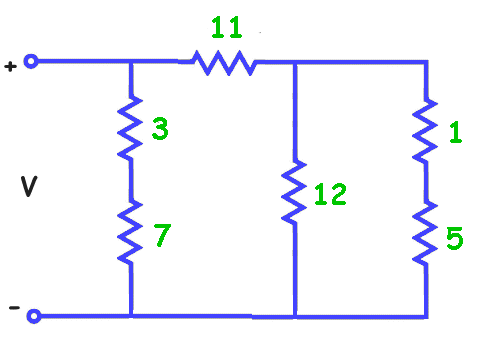Electric Circuit
All the electronics that we use today are based on complex electronic circuits. Electronic circuits combine components, wires, and electricity to accomplish some function.
Basic Circuit
The basic electronic circuit has a power source, wires connecting components, and components. Here is a simple example showing some resistors connected in parallel and series.

Schematic
The drawings of complex electronic circuits are called schematics. Schematics show how the different components are all connected together. There are standard symbols for different components that allow different engineers to work on the same project.
Example of a schematic
Printed Circuit Board
A printed circuit board is used to connect many different electronic components into a working circuit. The “wires” connecting the components are built right into the board. There are even different layers of the board with each layer having its own set of wires. Small holes called “vias” are drilled through the board to make connections from layer to layer. Components are then soldered to the surface of the board to make the electrical connections.
Power and Ground
In a complex printed circuit board there will generally be at least one layer dedicated to ground and one to the power supply. The layer for ground is called the ground plane. The ground plane serves as a return path for current for many of the components. Most active components have at least one pin that must connect to ground.
A complex circuit will also typically have at least one DC power supply. On some very complex circuit boards there may be multiple power supplies. A typical power supply will be +3.3V, +2.5V, or +1.8V depending on the technology used. Generally a full layer of the circuit board is dedicated to the main power supply voltage. This power supply is used to power the active components.
Passive Components
Passive components in a circuit are components that don’t require any external power. They reside in the current path of the circuit and don’t need to connect to the power supply. Some examples of passive components include resistors, capacitors, inductors, and connectors.
Active Components
Active components in a circuit need external power. They connect to the power supply and can inject power into the circuit such as amplifying a signal. Examples of active components include diodes, transistors, and integrated circuits such as the CPU in your computer.
Interesting Facts about Electronic Circuits
- The ground plane is often abbreviated as GND or with a symbol that looks like an upside down arrow or triangle.
- The term “printed circuit board” is often abbreviated as PCB.
- An analog circuit is one where the current or voltage varies continuously with time.
- A digital circuit is one where the electrical signals take on defined values that represent zeros and ones.
- There can be extremely complex circuits inside computer chips. High-end CPUs for computers have circuits made up of billions of transistors.
To learn more about Electric Circuit Join Radix Tree Online Multimedia Classes
Experience the Difference
1 to 1 live coaching

